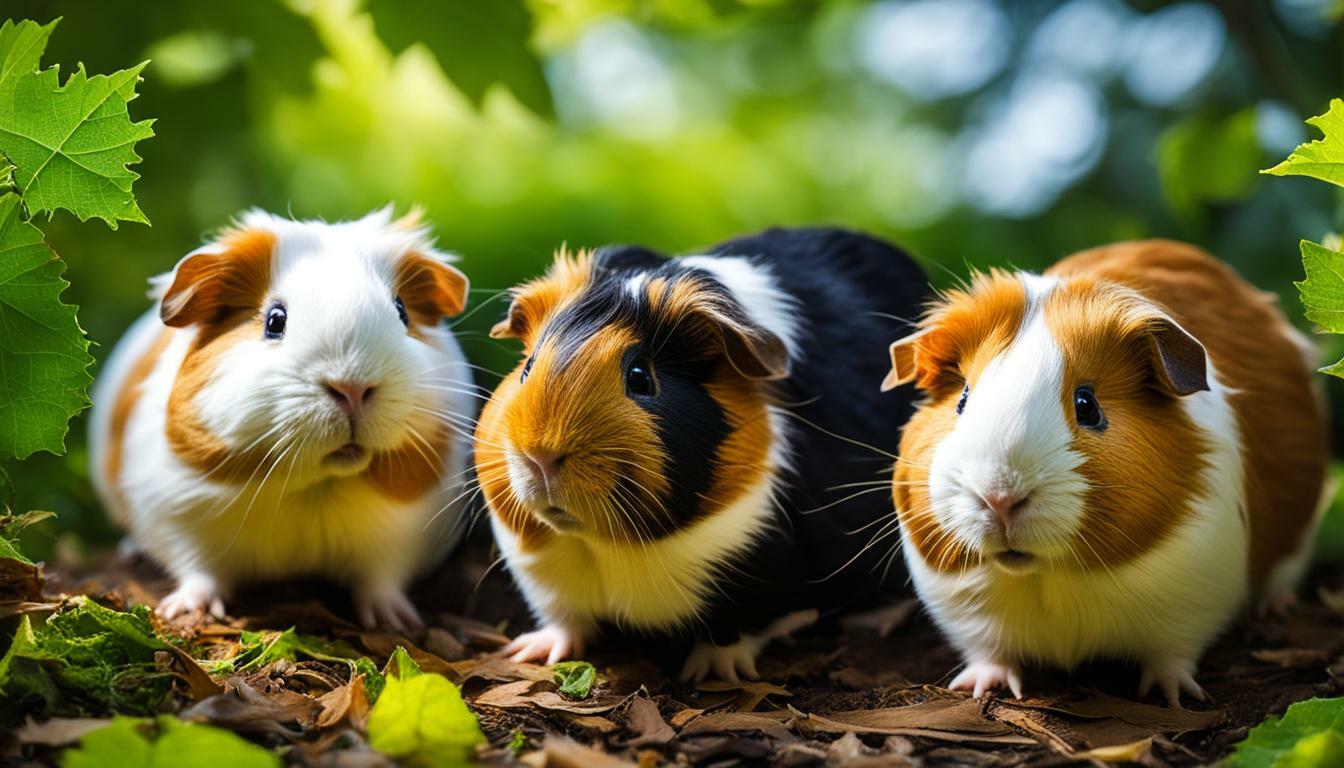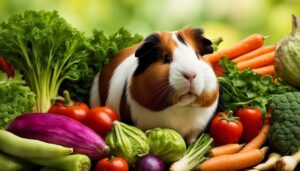Guinea pigs should not eat oak leaves as they are toxic and can be harmful to their health. Oak leaves contain tannins, which can cause digestive issues in guinea pigs. Ingesting oak leaves can lead to symptoms such as loss of appetite, ragged hair coat, digestive problems, inordinate affinity to water, weight loss, anemia, respiratory problems, nasal discharge, distended abdomen, abortion, dehydration due to constant urination, and even death.
If your guinea pig accidentally consumes oak leaves, it is important to take immediate action. Provide plenty of water to flush out the toxins and offer safer foods to help mitigate the effects. However, seeking veterinary care is crucial for proper treatment and to ensure your guinea pig’s well-being.
Prevention is key when it comes to oak leaf consumption. It is important to create a safe environment for your guinea pig, ensuring they do not have access to oak leaves. Additionally, closely monitoring their diet and providing a balanced and safe guinea pig diet is essential for their overall health and well-being.
While oak leaves are not suitable for guinea pigs, there are other tree leaves and branches that they can safely consume. Some examples include maple, apple, birch, pear, gogi berry, blackberry, European beech, rowan, alder, ash, fig, spruce, lilac, forsythia, broom, ginko, common hornbeam, dogwood, linden, hazel, bilberry/blueberry, raspberry, sea-buckthorn, currants, privet, pine, cherry, larch, mulberry, plum, poplar, peach, quince, blackthorn, gooseberry, fir, meadowsweet, elm, walnut, willow, grapevine, and hawthorn.
Key Takeaways:
- Guinea pigs should not eat oak leaves as they are toxic and can be harmful to their health.
- Ingesting oak leaves can lead to various symptoms and health problems in guinea pigs.
- If your guinea pig accidentally consumes oak leaves, provide plenty of water and seek veterinary care.
- Prevention is key – ensure guinea pigs do not have access to oak leaves and monitor their diet closely.
- There are other tree leaves and branches that guinea pigs can safely consume, such as maple, apple, birch, and more.
The Dangers of Oak Leaves for Guinea Pigs
Oak leaves pose significant dangers to guinea pigs due to their high tannin content, which can lead to various health issues. Guinea pigs are herbivores with specific dietary needs, and oak leaves are not a safe food option for them. Tannins found in oak leaves can cause digestive problems and disrupt their delicate digestive systems.
Ingesting oak leaves can result in a range of symptoms, including loss of appetite, a ragged hair coat, digestive issues, and an abnormal attraction to water. Guinea pigs may also experience weight loss, anemia, respiratory problems, nasal discharge, a distended abdomen, abortion in pregnant females, and dehydration due to increased urination. In severe cases, the ingestion of oak leaves can even lead to death.
If your guinea pig accidentally consumes oak leaves, it is important to take immediate action. Offer them plenty of water to help flush out toxins from their system. Additionally, provide safer foods that are suitable for guinea pigs to eat, such as hay, fresh vegetables, and guinea pig pellets. However, it is crucial to seek veterinary care as soon as possible for proper diagnosis and treatment.
| Safe Tree Leaves and Branches for Guinea Pigs |
|---|
| Maple |
| Apple |
| Birch |
| Pear |
| Gogi Berry |
| Blackberry |
| European Beech |
| Rowan |
| Alder |
| Ash |
It is essential to prevent guinea pigs from accessing oak leaves and closely monitor their food intake. Instead, offer them a balanced and varied diet that includes hay, fresh vegetables, limited fruits, and guinea pig pellets to ensure their well-being. Providing a safe environment for guinea pigs is equally important, which involves guinea pig-proofing their living space and eliminating potential hazards.
In conclusion, guinea pigs should never be fed oak leaves due to the harmful effects of tannins. These leaves can cause significant health issues and even be fatal to these small pets. It is crucial to prioritize their nutrition and well-being by offering them safe and appropriate foods, seeking veterinary care when needed, and providing a secure living environment.
Symptoms of Oak Leaf Toxicity in Guinea Pigs
Guinea pigs that have ingested oak leaves may exhibit various symptoms indicating oak leaf toxicity. These symptoms can range from mild to severe and may require immediate veterinary attention. It is important to recognize these signs in order to provide the necessary care and treatment for your guinea pig.
One common symptom of oak leaf toxicity in guinea pigs is a loss of appetite. If your normally voracious eater suddenly shows disinterest in food, it could be a sign that they have ingested oak leaves. Additionally, you may notice a ragged hair coat, as the toxins in oak leaves can affect the quality and texture of their fur.
Digestive problems are also common in guinea pigs that have consumed oak leaves. Diarrhea, constipation, or a change in bowel movements can be indications of oak leaf toxicity. Another symptom to watch for is an inordinate affinity to water. Guinea pigs that have ingested oak leaves may drink excessive amounts of water or show a constant need to urinate.
In more severe cases, guinea pigs may experience weight loss, anemia, respiratory problems, nasal discharge, a distended abdomen, abortion (in pregnant females), dehydration due to constant urination, and even death. If you observe any of these symptoms in your guinea pig, it is crucial to seek immediate veterinary care.
Treatment for Guinea Pigs That Ate Oak Leaves
If your guinea pig has eaten oak leaves, immediate actions such as providing water and safer foods can help mitigate the effects. Oak leaves are toxic to guinea pigs due to the presence of tannins, which can cause digestive issues and other health problems. It is crucial to act quickly to prevent further harm to your pet.
The first step is to offer your guinea pig plenty of fresh water. This will help flush out any toxins and hydrate their system. Ensure that the water is clean and readily available at all times. Additionally, you should provide safer foods that are part of a guinea pig’s balanced diet to counteract the effects of the oak leaves.
Feeding hay, fresh vegetables, and limited pellets can help normalize their digestive system and replenish the nutrients lost due to the toxicity. It is essential to avoid feeding any toxic foods, including oak leaves, and focus on providing safe options. Consulting a veterinarian is highly recommended to determine the appropriate course of action and ensure your guinea pig receives the necessary care.
Remember, prevention is key. Ensure that your guinea pig’s environment is free from oak leaves or any other potentially toxic plants. Regularly inspect their living space and remove any hazardous materials. By closely monitoring their diet and taking prompt action when necessary, you can help keep your guinea pig safe and healthy.
| Safe Tree Leaves and Branches for Guinea Pigs | |
|---|---|
| Maple | Gogi Berry |
| Apple | Blackberry |
| Birch | European Beech |
| Pear | Rowan |
| Alder | Ash |
| Fig | Spruce |
| Lilac | Forsythia |
| Broom | Ginko |
| Common Hornbeam | Dogwood |
| Linden | Hazel |
| Bilberry/Blueberry | Raspberry |
| Sea-Buckthorn | Currants |
| Privet | Pine |
| Cherry | Larch |
| Mulberry | Plum |
| Poplar | Peach |
| Quince | Blackthorn |
| Gooseberry | Fir |
| Meadowsweet | Elm |
| Walnut | Willow |
| Grapevine | Hawthorn |
Preventing Oak Leaf Consumption by Guinea Pigs
To protect your guinea pig, it is essential to prevent them from accessing oak leaves and carefully manage their diet. Oak leaves are toxic to guinea pigs and can cause a range of health problems. By taking proactive measures, you can ensure the safety and well-being of your furry friend.
Securing the Environment:
One of the first steps in preventing oak leaf consumption is to secure your guinea pig’s living space. Remove any oak trees or branches from their enclosure or play areas. Guinea pigs are curious creatures, and they may nibble on anything within their reach. Use fencing or barriers to create a safe and oak-free environment for them to explore.
Monitoring the Diet:
An important aspect of keeping your guinea pig safe is to closely monitor their diet. Provide a balanced and nutritious diet consisting of fresh vegetables, hay, pellets, and limited fruits. Avoid feeding them any toxic foods, including oak leaves. Offering a variety of safe tree leaves and branches, such as maple, apple, birch, and pear, can help satisfy their natural chewing instincts without posing any harm.
| Safe Tree Leaves for Guinea Pigs | Nutritional Benefits |
|---|---|
| Maple | Rich in vitamins and minerals |
| Apple | High in fiber and vitamin C |
| Birch | Contains antioxidants and supports urinary health |
| Pear | Provides essential vitamins and aids digestion |
| And more… | Each tree leaf offers unique nutritional benefits for guinea pigs |
Supervising Outdoor Time:
If you allow your guinea pig to have supervised outdoor time, ensure they are in a controlled environment away from oak trees. Even a small nibble on an oak leaf can have detrimental effects. Stay vigilant and redirect their attention to safe grazing areas with grass and other suitable vegetation.
By implementing these preventative measures, you can safeguard your guinea pig from the dangers of oak leaves. Remember to prioritize a well-balanced diet and provide a secure environment for their overall health and happiness.
Safe Tree Leaves and Branches for Guinea Pigs
While oak leaves are harmful, there are many other tree leaves and branches that guinea pigs can safely consume. These provide a variety of flavors and nutrients to their diet, contributing to their overall health and well-being. Here is a list of safe tree leaves and branches that you can offer to your guinea pigs:
| Safe Tree Leaves and Branches | Nutritional Benefits |
|---|---|
| Maple | Rich in antioxidants and vitamin C |
| Apple | High in fiber and vitamin A |
| Birch | Contains minerals such as potassium and calcium |
| Pear | Provides vitamin C and aids digestion |
| Gogi berry | Offers essential amino acids and antioxidants |
| Blackberry | Rich in vitamin C and fiber |
| European beech | Contains manganese and copper |
| Rowan | Provides vitamin C and antioxidants |
| Alder | Rich in potassium and vitamin C |
These are just a few examples of safe tree leaves and branches for guinea pigs. However, it’s important to remember that not all tree species are safe for them to consume. Always ensure that the tree leaves and branches you offer are free from pesticides, chemicals, and other potential contaminants. It’s also crucial to introduce new foods gradually and monitor your guinea pig’s response to them. If you notice any digestive issues or adverse reactions, discontinue feeding that specific tree leaf or branch. Providing a varied and balanced diet will help keep your guinea pigs happy and healthy.
Recognizing a Balanced Guinea Pig Diet
A balanced diet is crucial for maintaining the health and well-being of guinea pigs. These small, adorable creatures require a combination of essential nutrients to thrive and lead a happy life. Providing a varied and nutritious diet is key to ensuring their overall health. Here are some important components to consider when it comes to guinea pig nutrition:
- Hay: High-quality hay should form the foundation of a guinea pig’s diet. It provides essential fiber, aids in digestion, and keeps their teeth in good condition. Offer a variety of hays, such as timothy, orchard grass, or meadow hay, to add interest and ensure a well-rounded diet.
- Fresh Vegetables: Guinea pigs should have a daily serving of fresh vegetables. Leafy greens like romaine lettuce, spinach, and kale are excellent choices. Other safe options include bell peppers, carrots, cucumbers, and zucchini. Introduce new vegetables gradually to avoid digestive issues.
- Pellets: Guinea pig pellets should be specifically formulated for their nutritional needs. Look for pellets that are high in fiber, low in sugar and fat, and contain essential vitamins and minerals. Offer the pellets in small portions to supplement their diet and ensure they receive all the necessary nutrients.
- Limited Fruits: While fruits are a tasty treat for guinea pigs, they should be given in moderation due to their sugar content. Offer small amounts of fruits like apples, strawberries, blueberries, and melons as occasional treats. Remove any uneaten fruit to prevent spoilage.
Remember, each guinea pig is unique, and their dietary needs may vary. It is essential to consult with a veterinarian knowledgeable in guinea pig care to ensure you are providing the best diet for your furry friend. Additionally, always monitor their weight and adjust the portion sizes accordingly. By recognizing and maintaining a balanced guinea pig diet, you are prioritizing their well-being and setting them up for a long and happy life.
Seeking Veterinary Care for Guinea Pigs
If you suspect your guinea pig is experiencing any health issues, it is crucial to seek professional veterinary care. Guinea pigs are delicate animals, and prompt medical attention can make a significant difference in their well-being. When it comes to health concerns related to oak leaves or any other toxic substances, consulting a veterinarian is of utmost importance.
A qualified exotic pet veterinarian can properly assess your guinea pig’s condition and provide appropriate treatment. They have the knowledge and experience to diagnose any potential toxicity caused by oak leaves and recommend the best course of action. Seeking veterinary care promptly can help prevent further complications and ensure your guinea pig receives the necessary care to recover.
Remember that prevention is always better than cure, and by seeking veterinary care, you are taking an important step in safeguarding your guinea pig’s health. A veterinarian can also provide guidance on how to create a safe environment for your guinea pig, offer dietary recommendations, and address any other concerns you may have regarding their care and well-being.
In summary, if you observe any unusual symptoms or suspect your guinea pig has ingested oak leaves or any other toxic substances, contact a reputable exotic pet veterinarian immediately. Your veterinarian will provide the necessary care and guidance to ensure your guinea pig’s health is protected and they can lead a happy and healthy life.
Providing a Safe Environment for Guinea Pigs
Creating a safe environment is essential to promote the health and safety of your guinea pig. As a responsible pet owner, it is your duty to ensure that their living space is free from potential hazards. Here are some key considerations to keep in mind when setting up a safe environment for your furry friend:
- Cage selection: Choose a cage that is appropriate for the size of your guinea pig. It should be spacious enough to allow them to move around comfortably. Opt for cages with solid flooring made of materials such as plastic or solid metal, as wire floors can injure their delicate feet.
- Bedding: Provide suitable bedding that is safe and comfortable for your guinea pig. Avoid cedar or pine shavings, as they can emit harmful fumes. Instead, opt for bedding made of materials like paper-based bedding or fleece.
- Hazard elimination: Guinea pigs are curious creatures, so it’s important to remove any potential hazards from their environment. Ensure that there are no small objects, toxic plants, electrical cords, or chemicals within their reach.
- Temperature regulation: Guinea pigs are sensitive to extreme temperatures. Keep their living space in a cool and well-ventilated area, away from direct sunlight and drafts. Provide them with cozy hiding spots and bedding to help them regulate their body temperature.
By taking these steps, you can create a safe and secure environment that promotes the well-being of your guinea pig. Remember to regularly clean their cage, provide fresh water and food, and give them plenty of love and attention. A safe environment, combined with a balanced diet and regular veterinary care, will contribute to a happy and healthy life for your furry friend.
| Safe Tree Leaves and Branches for Guinea Pigs | Nutritional Benefits |
|---|---|
| Maple | High in fiber and vitamin C |
| Apple | Rich in vitamin C and antioxidants |
| Birch | Contains vitamin C and minerals like potassium and calcium |
| Pear | Good source of vitamin C and fiber |
| Gogi berry | High in antioxidants and vitamin C |
Conclusion
In conclusion, oak leaves are toxic to guinea pigs, and it is essential to provide them with a balanced and safe diet to ensure their health and happiness. Guinea pigs should not eat oak leaves as they contain tannins that can be harmful to their digestive system. Ingesting oak leaves can lead to a variety of health issues, including loss of appetite, ragged hair coat, digestive problems, and inordinate affinity to water.
If your guinea pig accidentally consumes oak leaves, it is important to take immediate action. Start by giving them plenty of water to help flush out any toxins in their system. Additionally, feed them safer foods to mitigate the effects and support their recovery. However, it is crucial to remember that these initial measures should be followed up with a visit to the veterinarian for further evaluation and treatment.
Prevention is key when it comes to keeping your guinea pig safe from oak leaf toxicity. Ensure that they do not have access to oak leaves by carefully monitoring their environment and removing any potential hazards. Providing a varied and balanced diet is also important to their overall well-being. Safe tree leaves and branches that you can offer your guinea pig include maple, apple, birch, pear, and many others. These options provide not only a safe alternative but also offer nutritional benefits for their health.
To ensure the best care for your guinea pig, it is crucial to seek veterinary attention when needed. If you suspect that your guinea pig has ingested toxic substances like oak leaves, do not hesitate to consult a veterinarian. They will be able to diagnose any potential health issues and provide the necessary treatment. Remember to choose a reliable exotic pet veterinarian who is experienced in guinea pig care.
In conclusion, oak leaves should be avoided in a guinea pig’s diet due to their toxic nature. By prioritizing a balanced and safe diet, along with providing a secure and hazard-free environment, you can help ensure the health and happiness of your beloved guinea pig.
FAQ
Can guinea pigs eat oak leaves?
No, guinea pigs should not eat oak leaves as they are toxic to them.
Why are oak leaves toxic to guinea pigs?
Oak leaves contain tannins, which can be harmful to guinea pigs and cause digestive issues.
What symptoms can oak leaf toxicity cause in guinea pigs?
Ingesting oak leaves can lead to loss of appetite, ragged hair coat, digestive problems, inordinate affinity to water, weight loss, anemia, respiratory problems, nasal discharge, distended abdomen, abortion, dehydration due to constant urination, and even death.
What should I do if my guinea pig accidentally eats oak leaves?
If your guinea pig accidentally eats oak leaves, give them a lot of water to flush out toxins, feed them safer foods to mitigate the effects, and take them to a vet for further treatment.
How can I prevent my guinea pigs from accessing oak leaves?
It is important to prevent guinea pigs from accessing oak leaves by securing their environment and closely monitoring their food intake.
What other tree leaves and branches can guinea pigs eat?
Guinea pigs can safely eat maple, apple, birch, pear, gogi berry, blackberry, European beech, rowan, alder, ash, fig, spruce, lilac, forsythia, broom, ginko, common hornbeam, dogwood, linden, hazel, bilberry/blueberry, raspberry, sea-buckthorn, currants, privet, pine, cherry, larch, mulberry, plum, poplar, peach, quince, blackthorn, gooseberry, fir, meadowsweet, elm, walnut, willow, grapevine, and hawthorn leaves and branches.




